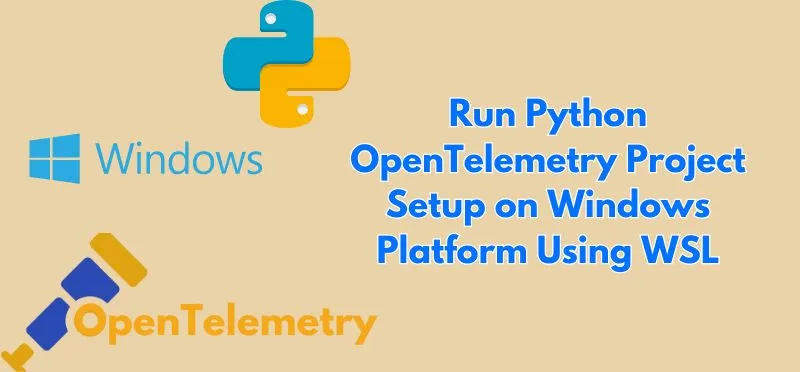OpenTelemetry is a set of tools, SDKs, and APIs. Utilize it to instrument, produce, gather, and export telemetry data (metrics, logs, and traces) for use in the performance and behavior analysis of your software.
OpenTelemetry is a single open-source standard that includes a set of technologies for capturing and exporting metrics, traces, and logs from cloud-native applications and infrastructure. Telemetry data gathering and export are challenged by the distributed nature of modern cloud-native apps.
Let’s go ahead in the article and learn more about the steps to run Python OpenTelemetry Project Setup on Windows Platform using WSL.
Step 1: Install WSL2 or WSL2+ on your device
Microsoft created the Windows Subsystem for Linux (WSL) 2 Linux kernel, which lets users run Linux distributions on Windows without having to worry about maintaining virtual machines. WSL 2 runs a Linux kernel within a virtual machine (VM) on top of the Windows host by utilizing virtualization technologies. Within the WSL 2 controlled virtual system, several Linux distributions operate in separate containers.
Proceed to the following step when your device has finished installing.
Read Also: Ultrafast Persistence on Jakarta EE || Treeleftbig.shop: Exploring the Budget-Friendly shopping
Step 2: Open Ubuntu on Your Device and Set the Local Port
Ubuntu is an open-source, free Linux operating system (OS) that may be used on virtual private servers and personal PCs. In addition to office suites, media apps, email, firewalls, and virus protection software, it also contains browsers.
Open Ubuntu on your machine and set the local port as shown below:
Inside Ubuntu, run the following command:
sudo nano /etc/resolv.conf
nameserver 8.8.8.8 nameserver 4.4.4.4
After this, Save the file and proceed to the next step.
Read Also: Snokido: Free Online Gaming, Rules, Feature and User Reviews || Bridging Agile And Continuous Data Management: A Synergetic Perspective
Step 3: Running Backstage Application in WSL2 or WSL2+
Install the git repository in your personal git account.
Now run the git clone using the command: Run git clone.
After the command runs, proceed to the next step.
Read Also: Are You Facing An Error When You Run the Startdagservermaintenance.Ps1 Script? || A Simple and Easy Method for Training GPT-2 To Generate Haiku Using the NanoGPT Repository
Step 4: Create a Virtual Environment for the project
A virtual environment is a networked program that allows users to engage with their computing environment as well as the work of other users. Virtual environments often include email, chat, and web-based document-sharing applications.
In Python programming and artificial intelligence (AI), a virtual environment is an isolated workplace where developers may work on separate projects without interfering with one another. Virtual environments are useful for verifying that software executes with the correct package or library versions. This helps to separate software projects from competing libraries and packages installed on an operating system.
For creating a Virtual environment we need a tool called Virtualenv.
A Python virtual environment (venv) is a folder with a specified file structure that includes the Python interpreter and third-party libraries. Changes to one virtual environment have no effect on the others since they are isolated. This allows you to set up numerous environments using different Python versions, libraries, or versions of the same libraries.
To install Venv run the following command:
Activate the virtual environment by typing in the host:
source env/bin/activate
Now your virtual environment is activated and you can proceed to the next step.
Read Also: 1414 Angel Number meaning || 1234 Angel Number Meaning || 1212 Angel Number Meaning
Step 5: Start the project in the editor, then link WSL and VS Code Editor.

A Python code editor is a stand-alone tool that allows users to create and edit programs. It is a vital tool used by developers and can be integrated with IDEs to expand programming capabilities.
There are many Python editors in the market:
For the Demonstration of the project in this article, we will be using one of the most popular Python editor ‘Visual Studio Code’
Visual Studio Code is a streamlined code editor that allows you to debug, conduct tasks, and use version control. It seeks to give only the tools a developer requires for a short code-build-debug cycle, leaving more sophisticated workflows to full-featured IDEs like Visual Studio IDE.
- You can download Visual Studio’s latest version .exe file by simply searching it on Google and installing it.
- Once completed, the Visual Studio is installed, and the project is opened within it.
- Once this has been opened, then you have to connect the WSL remote in the Visual Studio code editor and click on Open a Remote Window option.
- First, click the Windows remote button, then select the Connect to WSL option. Once the VS code editor has connected to WSL, open a project folder using the project path:
- After this, you can run the project either on Visual Studio Code or Ubuntu terminal.
- Before running the code you must first activate the virtual environment by the above mentioned code.
- Now set the path in the terminal and activate your virtual environment on Visual Studio code.
Read also: Error Handling Inside Kumologica Subflow || Angel Number 1313 Meaning
Step 6: Run Code in Virtual Studio Editor
You have to first check that you have installed all the git repository README.md files on the Github site and check if you have installed all packages and modules.
Check and install requirements.txt file modules, which are already available in the repository, using the following commands:
pip freeze > dev-requirements.txt
pip install -r dev-requirements.txt
pip install -r docs-requirements.txt
pip freeze > docs-requirements.txt
If you install all the components correctly you should not have to face any errors, If there is any error just search Google with the error code shown in the terminal of your interface on Visual Studio Code or Ubuntu whichever one you are using.
Finally, try running any test case file from the project, as indicated in the figure below. If it runs successfully and produces no errors, the code setup on a local system is complete.
Conclusion
To finalize this article we can say that all these processes are very challenging and you need basic knowledge of programming and Python and have a quiet idea about sites like GitHub and Reddit. You can face many errors if you don’t have a rough idea about Python and the virtual environment. By following the above steps you can easily run Python OpenTelemetry Project Setup on Windows Platform Using WSL.

